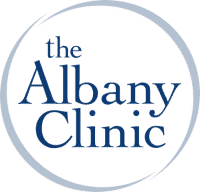In-Clinic vs. At-Home Ketamine Therapy: What’s Best for Your Mental Health?

Kimberly Mercille • July 9, 2025
As ketamine therapy becomes increasingly popular for treating mental health conditions like depression and PTSD, more people are exploring their options. At-home ketamine therapy gained traction during the pandemic for its convenience, but without medical supervision, this approach may come with elevated risks.
In this article, we’ll explore some of the key differences and pros and cons of in-clinic versus at-home ketamine therapy.
What Is In-Clinic Ketamine Therapy?
IV Ketamine Treatment
In-clinic ketamine therapy involves receiving treatment at a licensed medical facility, such as The Albany Clinic, where professionals monitor and administer the medication under strict protocols. This ensures your safety, especially during your initial sessions.
At The Albany Clinic, we specialize in intravenous (IV) ketamine infusion therapy, which has been most well-researched when it comes to treating mental health disorders. IV ketamine bypasses the digestive system, delivering the medication directly into the bloodstream. IV ketamine can help relieve symptoms of various mental health disorders, including depression, anxiety, post-traumatic stress disorder (PTSD), and more.
During an infusion at our clinic, you’ll rest in a calm, controlled environment while ketamine is delivered into a vein through a catheter. Our trained staff will closely monitor your vital signs and mental state throughout the session, adjusting the dose of ketamine if needed. We’ll observe you after treatment to ensure any side effects are managed promptly and effectively.
Spravato
We also offer Spravato (esketamine) at our clinic, a nasal spray based on ketamine. Unlike other forms of ketamine treatment, Spravato is approved by the FDA and is specifically for adults with treatment-resistant depression or major depressive disorder with suicidal thoughts.
Spravato is only approved for in-clinic use under professional supervision and cannot be administered at home, making clinical oversight a legal and medical necessity for this treatment option.
During a Spravato session, you’ll self-administer the medication under the supervision of our medical staff. We’ll then closely monitor you for a couple of hours to ensure you’re safe and all side effects have subsided before leaving.
What Is At-Home Ketamine Therapy?
At-home ketamine therapy allows patients to self-administer the ketamine, typically in the form of lozenges or nasal sprays, delivered via mail. While this option offers flexibility, it usually involves minimal supervision, often limited to virtual check-ins with healthcare providers.
Some at-home providers offer optional video support during sessions, but this is not always the case. Patients are largely responsible for monitoring their own physical and emotional reactions, without the benefit of immediate medical intervention if adverse effects occur.
At-home treatment often includes supplementary materials, such as guided meditations or journaling tools. However, the lack of real-time clinical oversight makes this option less ideal for those with complex or severe mental health needs.
Safety Considerations: In-Clinic vs. At-Home
While ketamine therapy is considered safe for most patients, it does come with potential physical and psychological side effects, including:
Physical Risks:
- Elevated blood pressure or heart rate
- Nausea or vomiting
- Sedation or dizziness
- Impaired coordination
- Rare allergic reactions
Psychological Risks:
- Hallucinations or dissociation
- Temporary confusion or anxiety
- Emotional vulnerability during treatment
- Risk of misuse or dependency
The FDA has issued warnings about at-home ketamine use due to its potential for abuse and lack of medical supervision. Without proper monitoring, the risk of addiction and long-term complications, such as bladder damage and cognitive decline, may increase.
Key Differences Between In-Clinic and At-Home Ketamine Therapy
| Feature | In-clinic therapy | At-home therapy |
|---|---|---|
| Supervision | Constant monitoring by medical staff | Limited or remote oversight |
| Administration | Typically as IV infusions, although some clinics provide intramuscular (IM), or Spravato nasal spray |
Oral lozenges or non-FDA nasal sprays |
| Safety Protocols | Real-time dose adjustments and emergency care | No immediate in-person intervention available |
| Environment | Calming, controlled medical setting | Familiar home setting, but may include distractions |
| Convinience | Requires visits to the clinic | Flexible options of when to dose and doesn’t require travel |
Who Should Consider In-Clinic vs. At-Home Ketamine Therapy?
In-clinic treatment at The Albany Clinic may be ideal for you if:
- You suffer from moderate to severe mental health conditions
- You are new to ketamine therapy and want medical supervision
- You want access to FDA-approved Spravato, which is only available in clinics
- You prefer a structured, supportive clinical environment
- You’ve experienced side effects from past treatments and need close observation
When Is At-Home Ketamine Therapy Appropriate?
At-home therapy might be suitable if:
- You’re dealing with mild to moderate symptoms
- You’ve already undergone in-clinic sessions and are on a maintenance plan
- You have limited access to a clinic due to location or mobility issues
- You feel confident managing the experience with remote guidance
In-Clinic Ketamine & Spravato Therapy in Albany, Georgia
At The Albany Clinic, we are dedicated to delivering safe, medically supervised infusion therapy tailored to your unique needs. Whether you are new to ketamine treatment or seeking a reliable partner for your mental health care, our team is here to support you every step of the way.
We offer both IV ketamine infusions and Spravato therapy, all administered in a calm, professional setting. If you’re considering ketamine treatment, we invite you to contact us and schedule a consultation to see how we can help.






